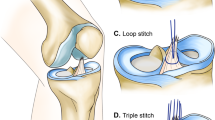Abstract
In order to observe the remodeling process of the inter-strand of the four-strand graft used for anterior cruciate ligament (ACL) reconstruction, and to find the histological and biomechanical influences on this process by braiding the four-strand graft, we conducted this study in a rabbit model. The rabbit’s ACLs were reconstructed with bilateral four-strand semitendinous tendons which are in parallel or braided shape. The specimens of the two groups were collected at 3, 6, 12, 26 and 52 weeks after the operation. Gross and histological observations were done and the biomechanical properties of the specimens of the 26 and 52 weeks were compared. The result showed that in regular group, at 3 weeks, the strands which were in necrosis status were still separated with each other. At 6 weeks, the grafts were enveloped with hyperplastic synovium, some outer part of the gaps between strands were filled with synovium and fused together, while the inner parts were still separated. At 12 weeks, the graft was still in remodeling progress, but the remodeling degrees of each strand were different. Some strands had fused but some were still separated with “big” interval. At 26 and 52 weeks, some inter-strand gaps were hard to discriminate, some strands were connected with connective tissue and some separated ones still showed up. The braided ones manifested a similar but more synchronized remodeling process and showed a higher inter-strands fusing rate. The biomechanical test showed that the strength of the reconstructed ACL of the regular unbraided tendons was 36% of the contralateral normal ACL, while the braided ones reached 67%. The graft strengths of the specimen of the 26 and 52 weeks in the braided graft group were significantly higher than that of the unbraided group, while the stiffness of the 52-week specimen of the braided group was significantly higher than that of the unbraided group also. From this study, we concluded that as a graft for reconstruction of the ACL, the four-strand hamstring tendon needs to pass through the necrosis, revascularization, and ligamentation progress, but different strands were not in a synchronous process. The inter-strand gap may be completely fused, partial fused, fused but connected with connective tissue or still separated. By braiding the strands, the fusing percentage of the graft could be elevated and the biomechanical properties could be improved.





Similar content being viewed by others
References
Amiel D, Kleiner JB, Akeson WH (1986) The natural history of the anterior cruciate ligament autograft of patellar tendon origin. Am J Sports Med 14:449–462
Amiel D, Kleiner JB, Roux RD, Harwood FL, Akeson WH (1986) The phenomenon of “Ligamentization”: anterior cruciate ligament reconstruction with autogenous patellar tendon. J Orthop Res 4:162–172
Anderson K, Seneviratne AM, Izawa K, Atkinson BL, Potter HG, Rodeo SA (2001) Augmentation of tendon healing in an intraarticular bone tunnel with use of a bone growth factor. Am J Sports Med 29:689–698
Arnoczky SP, Torzilli PA, Warren RF, Allen AA (1998) Biologic fixation of ligament prostheses and augmentations: an evaluation of bone ingrowth in the dog. Am J Sports Med 16:106–112
Arnoczky SP, Warren RF, Minei JP (1986) Replacement of the anterior cruciate ligament using a synthetic prosthesis. An evaluation of graft biology in the dog. Am J Sports Med 14:1–6
Falconiero RP, DiStefano VJ, Cook TM (1998) Revascularization and ligamentization of autogenous anterior cruciate ligament grafts in humans. Arthroscopy 14:197–205
Ferretti A, Conteduca F, Morelli F, Monteleone L, Nanni F, Valente M (2003) Biomechanics of anterior cruciate ligament reconstruction using twisted doubled hamstring tendons. Int Orthop 27:22–25
Howell SM, Taylor MA (1996) Brace-free rehabilitation with early return to activity for knees reconstructed with a double-looped semitendinous and gracilis graft. J Bone Joint Surg Am 78:814–821
Kim DH, Wilson DR, Hecker AT, Jung TM, Brown CH Jr (2003) Twisting and braiding reduces the tensile strength and stiffness of human hamstring tendon grafts used for anterior cruciate ligament reconstruction. Am J Sports Med 31:861–867
Lim JK, Hui J, Li L, Thambyah A, Goh J, Lee EH (2004) Enhancement of tendon graft osteointegration using mesenchymal stem cells in a rabbit model of anterior cruciate ligament reconstruction. Arthroscopy 20:899–910
Liu SH, Yang RS, al-Shaikh R, Lane JM (1995) Collagen in tendon, ligament and bone healing. Clin Orthop 318:265–278
Nicklin S, Waller C, Walker P, Chung WK, Walsh WR (2000) In vitro structural properties of braided tendon grafts. Am J Sports Med 28:790–793
Park MJ, Lee MC, Seong SC (2001) A comparative study of the healing of tendon autograft and tendon-bone autograft using patellar tendon in rabbits. Int Orthop 25:35–39
Rittmeister M, Noble PC, Lintner DM, Alexander JW, Conditt M, Kohl HW 3rd (2002) The effect of strand configuration on the tensile properties of quadrupled tendon grafts. Arthroscopy 18:194–200
Rougraff B, Shelbourne KD, Gerth PK, Warner J (1993) Arthroscopic and histologic analysis of human patellar tendon autografts used for anterior cruciate ligament reconstruction. Am J Sports Med 21:277–284
Sakai H, Fukui N, Kawakami A, Kurosawa H (2000) Biological fixation of the graft within bone after anterior cruciate ligament reconstruction in rabbits: effects of the duration of postoperative immobilization. J Orthop Sci 5:43–51
Scranton PE Jr, Lanzer WL, Ferguson MS, Kirkman TR, Pflaster DS (1998) Mechanisms of anterior cruciate ligament neovascularization and ligamentization. Arthroscopy 14:702–716
Tis JE, Klemme WR, Kirk KL, Murphy KP, Cunningham B (2002) Braided hamstring tendons for reconstruction of the anterior cruciate ligament. A biomechanical analysis. Am J Sports Med 30:684–688
Unterhauser FN, Bail HJ, Höher J, Haas NP, Weiler A (2003) Endoligamentous revascularization of an anterior cruciate ligament graft. Clin Orthop Relat Res 414:276–288
Author information
Authors and Affiliations
Corresponding author
Rights and permissions
About this article
Cite this article
Xu, Y., Ao, Yf. Histological and biomechanical studies of inter-strand healing in four-strand autograft anterior cruciate ligament reconstruction in a rabbit model. Knee Surg Sports Traumatol Arthrosc 17, 770–777 (2009). https://doi.org/10.1007/s00167-009-0764-6
Received:
Accepted:
Published:
Issue Date:
DOI: https://doi.org/10.1007/s00167-009-0764-6




